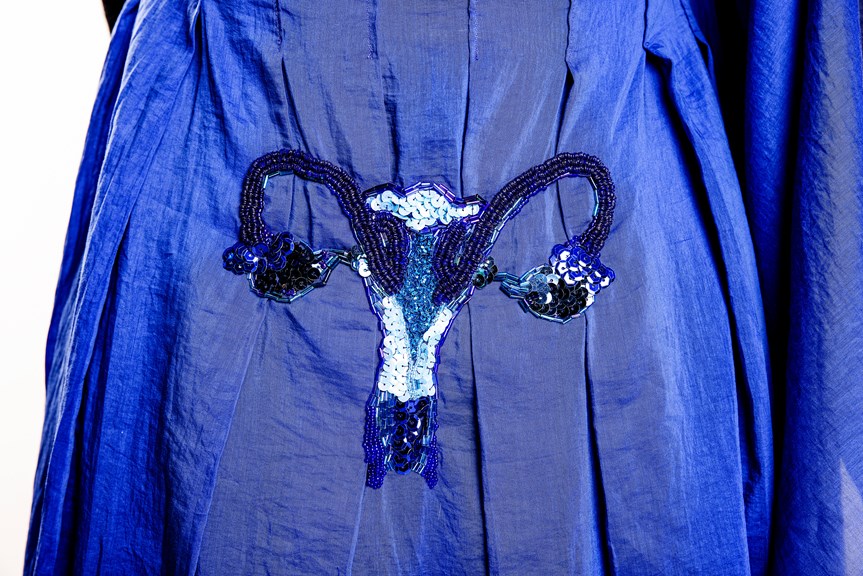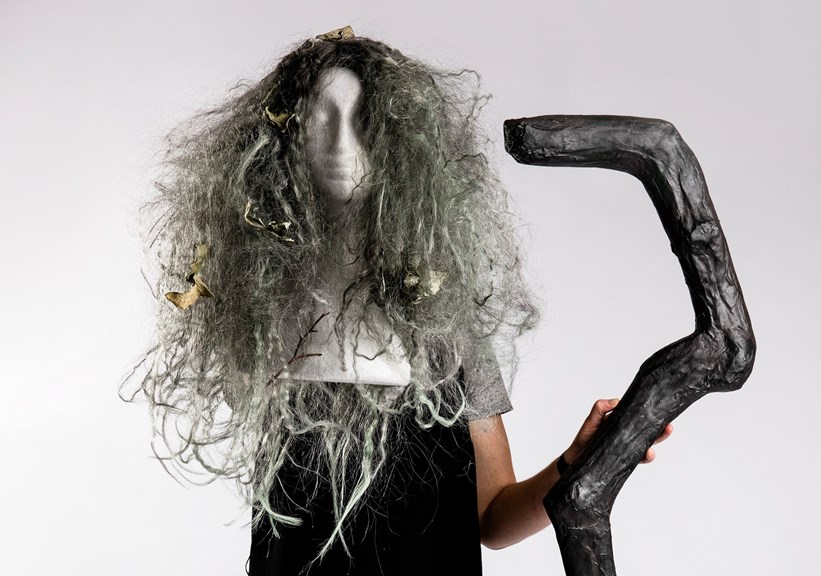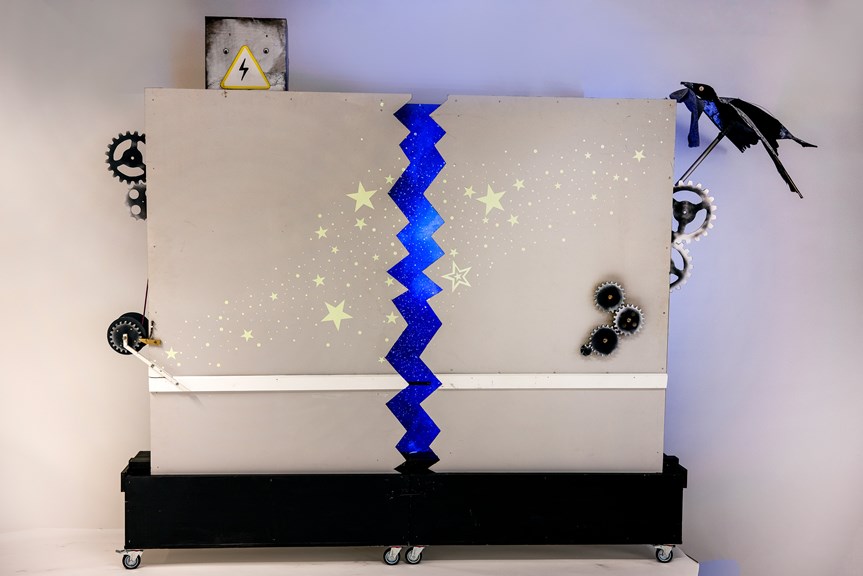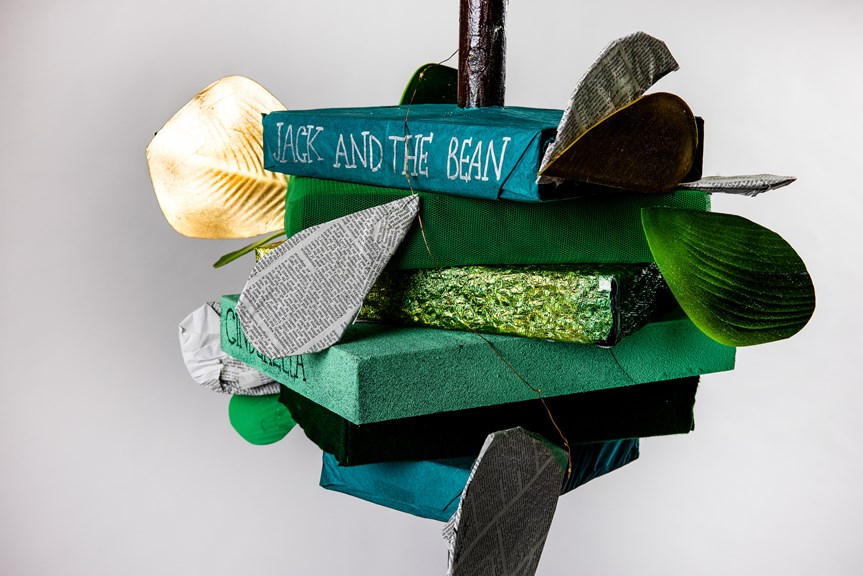Theatre Studies
Theatre as a form of cultural expression has been performed for audiences from the early ages and is an integral part of all cultures. In VCE Theatre Studies, through practical and theoretical engagement with scripts, from the pre-modern era to the present day, students gain an insight into the history and rich possibilities of script-based theatrical production.
Students in VCE Theatre Studies select a monologue from an annual list. They explore the context of the script, including the time, place, culture, playwright, theatrical style, language and meaning. In the examination, students interpret the monologue, either through acting and direction or through two areas of design. They also deliver an oral statement that explains and justifies their interpretive choices.
Sebastian Durham
Princes Hill Secondary College, Carlton North
Nurse (Medea, Euripides)
Costume and sound: Silk cotton, sequins, beads, canvas
Following the dramaturgical styles of Greek theatre and the Theatre of Cruelty, I have interpreted the monologue in an eclectic and atemporal mode that draws from feminism, postmodernism and the abject. My design samples multiple historical and social contexts (ancient Greece, 2010 Ireland and 2020 Australia) to illuminate the Nurse’s social position and role within the play, the issues that face her, and their ongoing contemporary significance.
My interpretation of the Nurse has grown out of my response to her sympathy with and connection to Medea and their shared experiences as women facing subjugation in an ancient society. The themes of motherhood, womanhood and the other are integral to my interpretation. In my costume design, these themes are emphasised by the beaded organs, which symbolise the limiting role available to women, and the colour blue, which gestures to maternity. In my sound design, I have included contemporary sounds of domestic labour as a way of drawing a link between ancient and contemporary contexts.
Within my consideration of safe and ethical practices, I have had to consider my position as a male designer attempting to illuminate the female experience and the dangers of creating an essentialist narrative through a bodily representation in the beaded organs. For balance I have been guided by the possibilities implicit in Euripides’ text and Tom Paulin’s reworking.
I have worked predominantly with the composition element of contrast within my sound and costume designs. My costume juxtaposes conventional depictions of ancient Greece and ancient women’s lives with the lived experience of the Nurse. My sound design employs variation and contrast to emphasise the tonal shifts within the monologue, which highlights and foreshadows the precarious positions of both women.
Mercedes Gowlett
Bellarine Secondary College, Drysdale
Virtual School Victoria, Thornbury
Witch (Into the Woods, James Lapine and Stephen Sondheim)
Make-up and props: Wig, leaves, acrylic paint, paper
My dramaturgical research revealed that the Grimm Brothers’ tales had a significant impact on the playwrights, James Lapine and Stephen Sondheim. Lapine really wanted to explore ‘the other side of the coin’ by tapping into the darkness of the original fairytales. By incorporating this darkness in my make-up design, the original intentions of Lapine and Sondheim are given prominence.
Through my carefully chosen design elements, the focus of the audience is constantly manipulated. Fairytales usually focus on the individual, which is how Sondheim and Lapine convey the characters in Act 1, before making all of the characters collide and forcing them to work collectively in Act 2. As this monologue introduces the Witch for the first time, it allows the audience to really focus on her and her distinguishing features, such as her distorted facial elements and wild hair.
By aging the actor’s face through a thick layer of foundation and dark contouring, the Witch’s ugliness is emphasised and her desperate wish to reclaim her youthful beauty is highlighted.
Gothic theatre really influenced my design, as demonstrated through the staff. Obsession and control are a big part of Gothic theatre and through the magical staff the Witch is able to show her obsessive need to regain her youth and beauty. Throughout the show the woods represent danger and often change the course of each character’s destiny. This is represented through the shape of the staff and how it twists and turns, just like the unpredictability of the woods.
When Into the Woods was first written, it broke with many of the conventional elements of musical theatre through the creation of a fractured fairytale world. My make-up and prop designs are bold, exaggerated and distorted just as Sondheim and Lapine intended the Witch to be.
Jaime Morcos
Caulfield Grammar School, St Kilda East
Narrator / Sock Thom / Shadow Terry / Sock Alethea / Power Box (Boy Girl Wall, Matthew Ryan and Lucas Stibbard)
Set and sound: Pine wood, laminated boards, casters, wall paint, metal latches, plywood sheets, wooden frame, recycled dado rail, phosphorescent stickers, LED strips, motor, wires, switches, duct tape, base of beach umbrella, paint roller stick, papier-mâché, acrylic paint, googly eyes, hot glue, string, pulleys, cardboard, spray paint, sequins
My interpretation of the monologue from Boy Girl Wall was informed by my dramatological research and the playwrights’ main vision. The vision of The Escapists theatre company is to create strong stories with an emphasis on imagination and the joy of play and with an aesthetic that challenges traditional theatre. This play jumps across the timeline of Earth’s existence from the beginning of time to the events of the story in 2012. The play is set in Brisbane’s West End, mainly in Thom and Alethea’s neighbouring flats. However, the monologue takes place in a dream sequence within Thom’s mind and apartment.
Boy Girl Wall has an eclectic theatrical style, but elements of non-naturalism and epic theatre can be seen through the play’s use of narration, breaking of the ‘fourth wall’ and a non-linear story structure. Themes of love, escapism and the formulaic existence of the middle class are central to telling the story of Thom and Alethea. I chose to focus on Thom’s fear of his office job and his place in the larger world.
Overall, Boy Girl Wall has an emphasis on comedy, which I tried to reflect through my production roles of set and sound. This can be seen in the googly eyes on the power box and magpie, as well as the sudden changes in music.
My design references the cartoonlike and childish naivety of Thom’s position in the world. However, I have accompanied this with mechanical elements in my set and sound to represent Thom as just another cog in the corporate machine.
Zoe Parker-Nentis
Lauriston Girls’ School, Armadale
Jack (Into the Woods, James Lapine and Stephen Sondheim)
Set and costume: Lockable wheels, wood, Styrofoam, tissue paper, newspaper, glitter sheen, acrylic paint, artificial leaves, PVA glue, hot glue, electrical tape, felt fabric, adhesive glue, mesh, Sharpie, copper wire lights, artificial vines, spray paint, cotton thread, 1960s side hat, cotton shirt, waist coat, jacket, three-quarter pinstriped pants, felt shoes, tan suspenders
As a designer I have been inspired by scriptwriters James Lapine and Stephen Sondheim’s intention to weave all the fairytales together, while placing emphasis on the moral of the stories: ‘Be careful what you wish for’.
My designs have also been influenced by the style of musical theatre, especially through the implementation of exaggerated movements and expressions, as well as song and dance. The magical aspect of the play can be seen in the glitter sheen on the outer layers of my designs.
My set design specifically utilises the theatre composition element of cohesion: as the newspaper and storybook pages arranged on the beanstalk and painted steps reflect the stories’ interconnection. Similarly, cohesion is represented in my costume designs; Jack’s costume is green like the beanstalk and it is also covered with the same newspaper and storybook pages. This is to further illustrate that Jack has literally been taken from a book.
My set designs have also been constructed for the actor to manipulate the theatre composition element of motion. This is due to the many levels on set in which the actor is able to jump around, thus depicting Jack’s carefree nature. My set also provides the actor with opportunities to utilise the musical theatre convention of exaggerated movement. My costume has been designed to suit these acting requirements too, as the pants and shirt are stretchy and encourage a wide variety of movement.
To entertain the audience and draw them into the same world as the fairytale characters, Lapine and Sondheim have manipulated rhythm and music. I have manipulated my set and costume to echo this idea.
Alexander Perri
Thornbury High School, Thornbury
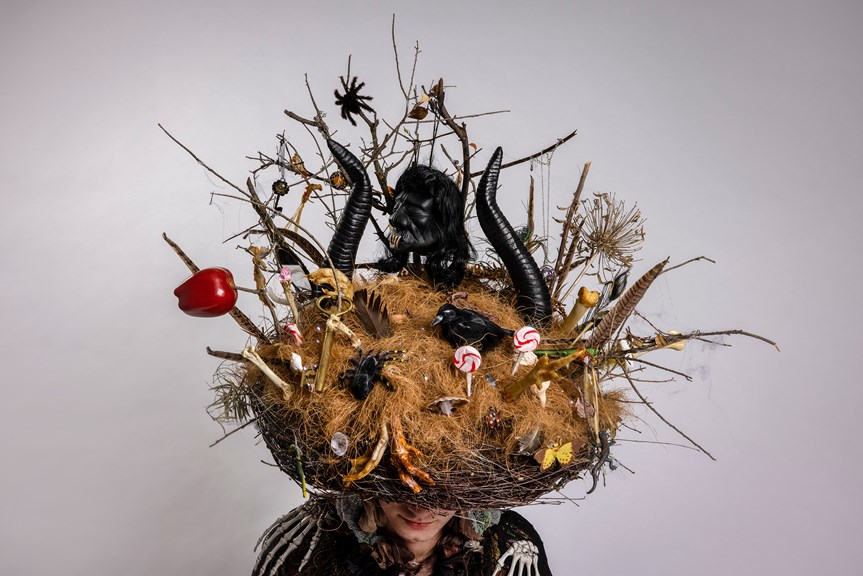
Witch (Into the Woods, James Lapine and Stephen Sondheim)
Costume: Bike helmet, liquid nails, expanding foam, coconut fibre, paint, hot glue, dried twigs, branches, remote control lights, foil, raven, lolly pops, chicken feet, duck feet, shells, air dry clay, plastic, wool, gem stones, chicken bones, vinyl goat horns, feathers, polyester spiders web, vinyl Voodoo shrunken head, plastic apple, plastic toys, costume jewellery, plastic baby, PVC barbed-wire, brass key, spray glue, felt, wool, Velcro, polyester fibre filling
I was fascinated by how the Witch could portray many witches in the world of play, not just in the tale of Rapunzel. My research into voodoo influenced my use of potion ingredients, which are symbols for rituals that work together to build the character’s spells and lift her curses. I used the potion ingredients to cover her body and literally weigh her down.
My Witch is a voodoo-inspired amalgamation of all the witches in European fairytales. I was influenced by musical theatre and its conventions of ‘magnificent costumes’ and the elements of grand spectacle. I was also influenced by Gothic horror and the convention of supernatural beings.
My costume design utilised the theatre composition element of emphasis and my prop pieces used variation to depict the Witch’s ingredients. Both areas have manipulated motion. My audience is those acquainted with a multitude of European fairytales. My nest headpiece holds objects that the actor interacts with for prop comedy. These objects are designed to engage an multigenerational audience. My designs demonstrate a juxtaposition of the dark threat the Witch poses and the moments of comedic ‘magic’ to support the levity of the song.
